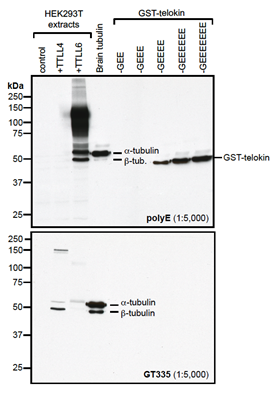anti-Polyglutamate chain [Poly-E] pAb (IN105)
Product Code:
AG-25B-0030
AG-25B-0030
Antibody Clonality:
Polyclonal
Polyclonal
Regulatory Status:
RUO
RUO
Target Species:
Universal
Universal
Applications:
- Immunocytochemistry (ICC)
- Immunohistochemistry (IHC)
- Western Blot (WB)
Shipping:
-20°C
-20°C
Storage:
-20°C
-20°C
No additional charges, what you see is what you pay! *
| Code | Size | Price |
|---|
| AG-25B-0030-C050 | 50 ug | £371.00 |
Quantity:
Prices exclude any Taxes / VAT
Stay in control of your spending. These prices have no additional charges to UK mainland customers, not even shipping!
* Rare exceptions are clearly labelled (only 0.14% of items!).
* Rare exceptions are clearly labelled (only 0.14% of items!).
Multibuy discounts available! Contact us to find what you can save.
This product comes from: Switzerland.
Typical lead time: 7-10 working days.
Contact us for more accurate information.
Typical lead time: 7-10 working days.
Contact us for more accurate information.
- Further Information
- Documents
- References
- Show All
Further Information
Concentration:
Lot dependent
EClass:
32160000
Form (Short):
liquid
Formulation:
Liquid. In PBS containing 0.02% sodium azide.
Handling Advice:
Do not freeze.
Immunogen:
Polyglutamate peptide.
Long Description:
Polyclonal Antibody. Recognizes C-terminally located linear glutamate chains of 4 and more glutamate residues. Source: Rabbit. Applications: ICC, IHC, WB. Liquid. In PBS containing 0.02% sodium azide. Microtubules are key elements of the eukaryotic cytoskeleton that dynamically assemble from heterodimers of alpha- and beta-tubulin. Two different mechanisms can generate microtubule diversity: the expression of different alpha- and beta-tubulin genes, referred to as tubulin isotypes, and the generation of posttranslational modifications (PTMs) on alpha- and beta-tubulin. Tubulin PTMs include the well-known acetylation or phosphorylation, and others that have so far mostly been found on tubulin, detyrosination/tyrosination, polyglutamylation and polyglycylation. These PTMs might have evolved to specifically regulate tubulin and microtubule functions. Polyglutamylation is a PTM that occurs when secondary glutamate side chains are formed on gamma-carboxyl groups of glutamate residues in a protein. Enzymes catalyzing polyglutamylation belong to the TTL-like (TTLL; Tubulin tyrosine ligase-like) family of glutamylases. Deglutamylases, the enzymes that reverse polyglutamylation, were identified within a novel family of CCPs (cytosolic carboxypeptidase). Subtle differences in polyglutamylation can be seen on diverse microtubules in different cell types. The functions of these modifications remain to be studied. However, its wide distribution strengthens the idea that it could be involved in fine-tuning a range of microtubule functions.
Package Type:
Plastic Vial
Product Description:
Microtubules are key elements of the eukaryotic cytoskeleton that dynamically assemble from heterodimers of alpha- and beta-tubulin. Two different mechanisms can generate microtubule diversity: the expression of different alpha- and beta-tubulin genes, referred to as tubulin isotypes, and the generation of posttranslational modifications (PTMs) on alpha- and beta-tubulin. Tubulin PTMs include the well-known acetylation or phosphorylation, and others that have so far mostly been found on tubulin, detyrosination/tyrosination, polyglutamylation and polyglycylation. These PTMs might have evolved to specifically regulate tubulin and microtubule functions. Polyglutamylation is a PTM that occurs when secondary glutamate side chains are formed on gamma-carboxyl groups of glutamate residues in a protein. Enzymes catalyzing polyglutamylation belong to the TTL-like (TTLL; Tubulin tyrosine ligase-like) family of glutamylases. Deglutamylases, the enzymes that reverse polyglutamylation, were identified within a novel family of CCPs (cytosolic carboxypeptidase). Subtle differences in polyglutamylation can be seen on diverse microtubules in different cell types. The functions of these modifications remain to be studied. However, its wide distribution strengthens the idea that it could be involved in fine-tuning a range of microtubule functions. PolyE labels centrioles as they mature, such that two foci are present throughout the cell cycle.
Source / Host:
Rabbit
Specificity:
Recognizes C-terminally located linear alpha-glutamate chains of 4 and more glutamate residues.
Transportation:
Non-hazardous
UNSPSC Category:
Primary Antibodies
UNSPSC Number:
12352203
Use & Stability:
Stable for at least 1 year after receipt when stored at -20°C.
Documents
References
Tubulin polyglutamylation stimulates spastin-mediated microtubule severing: B. Lacroix, et al.; J. Cell Biol. 189, 945 (2010) | Microtubule detyrosination guides chromosomes during mitosis: M. Barisic, et al.; Science 348, 6236 (2015) (Supplement) | Zika virus causes supernumerary foci with centriolar proteins and impaired spindle positioning: B. Wolf, et al.; Open Bio 7, 160231 (2017) | Alterations in the balance of tubulin glycylation and glutamylation inphotoreceptors leads to retinal degeneration: M. Bosch Grau, et al.; J. Cell. Sci. 130, 938 (2017) | Spastin regulates VAMP7-containing vesicles trafficking in cortical neurons: C. Plaud, et al.; BBA - Molecular Basis of Disease 1863, 1666 (2017) | iPSCs from a Hibernator Provide a Platform for Studying Cold Adaptation and Its Potential Medical Applications: J. Ou, et al.; Cell 173, 1 (2018) | Imaging cellular ultrastructures using expansion microscopy (U-ExM): D. Gambarotto, et al.; Nat. Methods 16, 71 (2018) | Essential function of the alveolin network in the subpellicular microtubules and conoid assembly in Toxoplasma gondii: N. Tosetti, et al.; eLife, Microbiol. Infect. Dis. 9, e56635 (2020) | Mutation of NEKL-4/NEK10 and TTLL genes suppress neuronal ciliary degeneration caused by loss of CCPP-1 deglutamylase function: K.M. Power, et al.; PLoS Genet. 16, e1009052 (2020) | Tubulin glycylation controls axonemal dynein activity, flagellar beat, and male fertility: S. Gadadhar, et al.; Science 371, eabd4914 (2021) | Essential function of the alveolin network in the subpellicular microtubules and conoid assembly in Toxoplasma gondii: N. Tosetti, et al.; eLife 9, e56635 (2021) | Proteomic analysis of Giardia lamblia and Trichomonas vaginalis flagella reveal unique post-translational modifications in tubulin that provide clues to regulation of their motilities: A. Sudhakar, et al.; Proteomics e2100004 (2021) | Regulators of tubulin polyglutamylation control nuclear shape and cilium disassembly by balancing microtubule and actin assembly: L. Wang, et al.; Nature Cell Res. ahead of print (2021)



